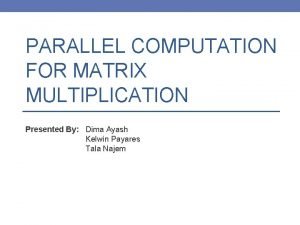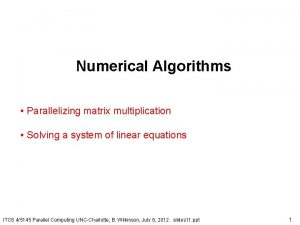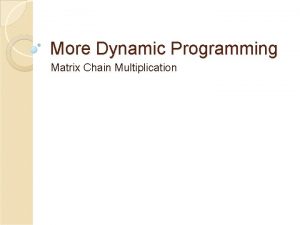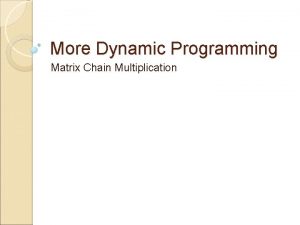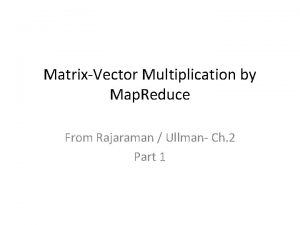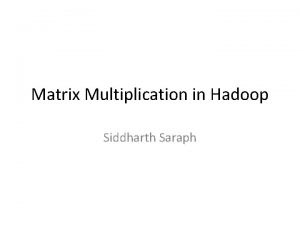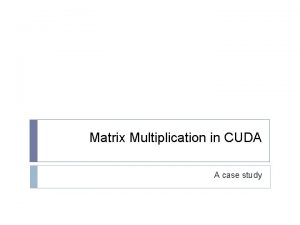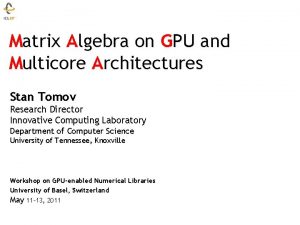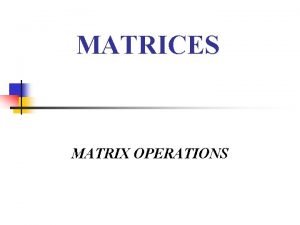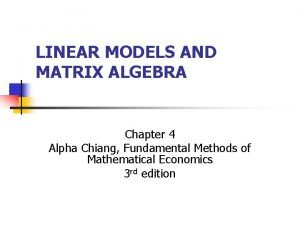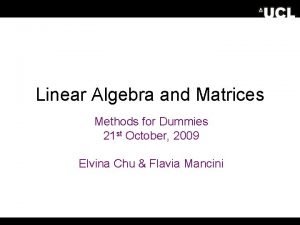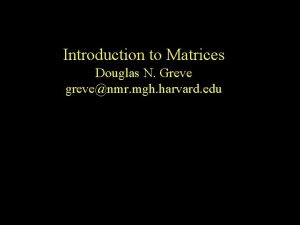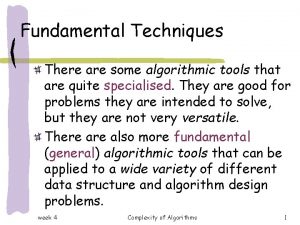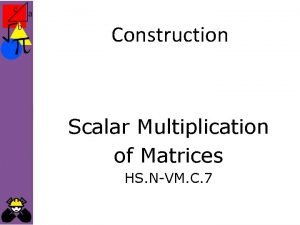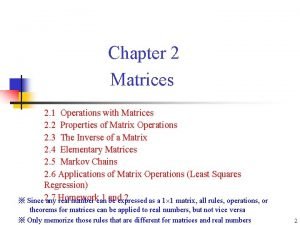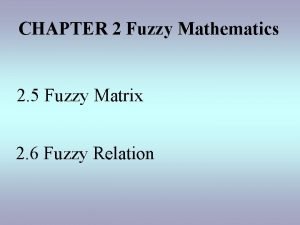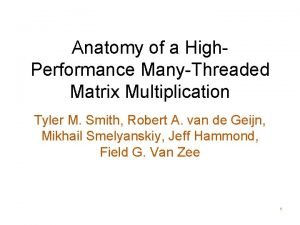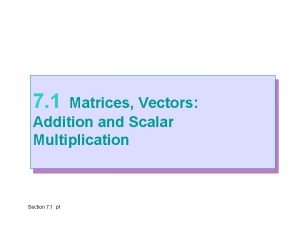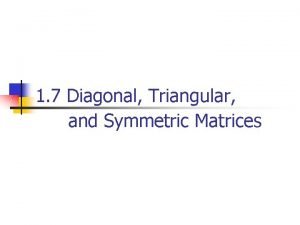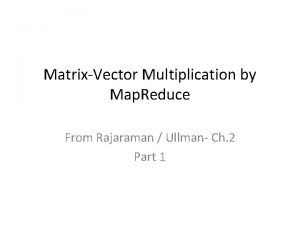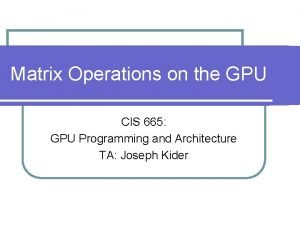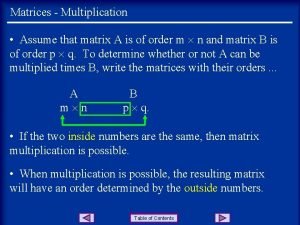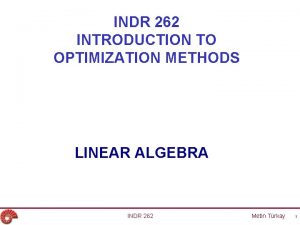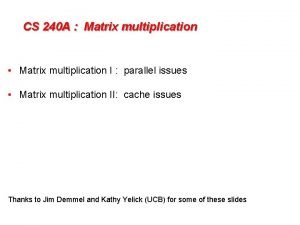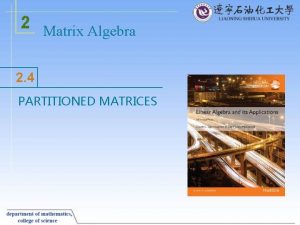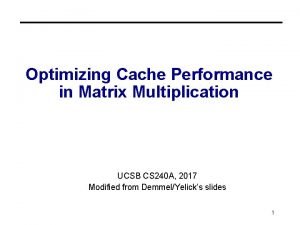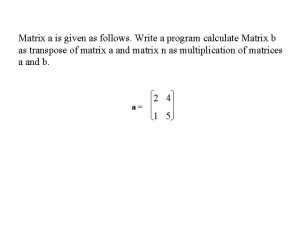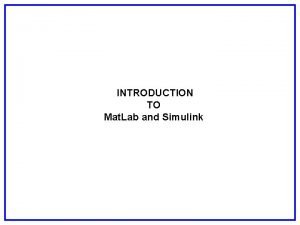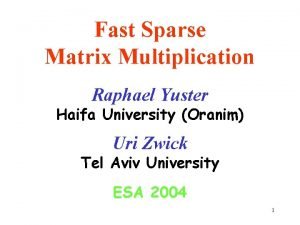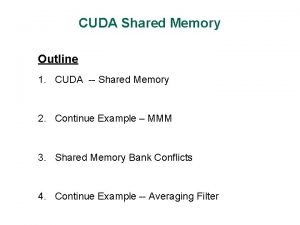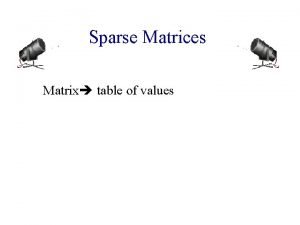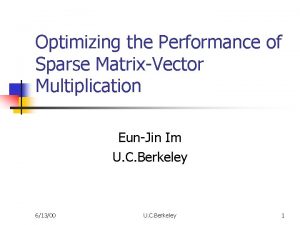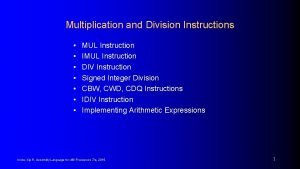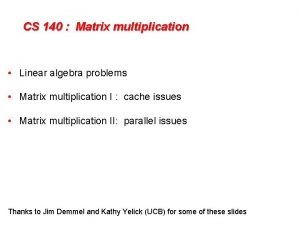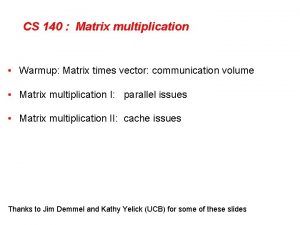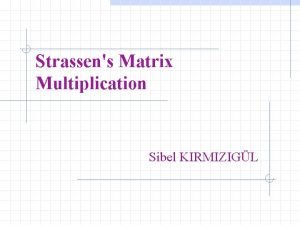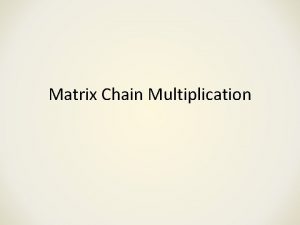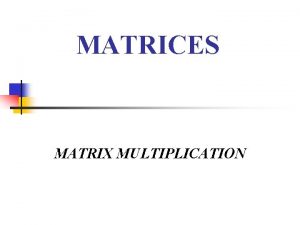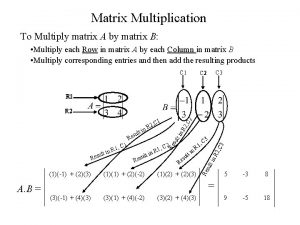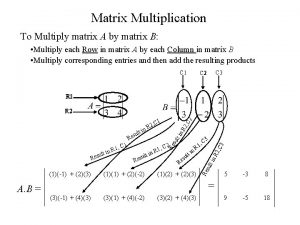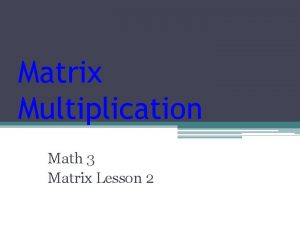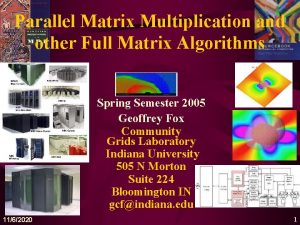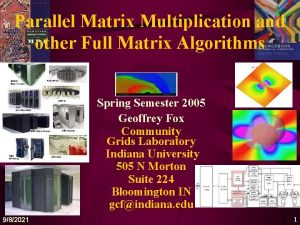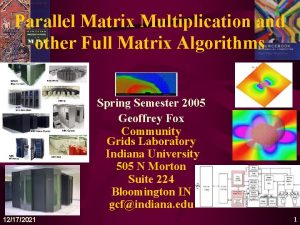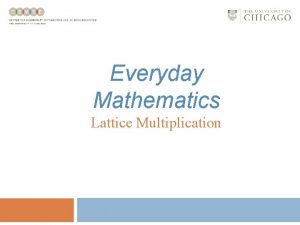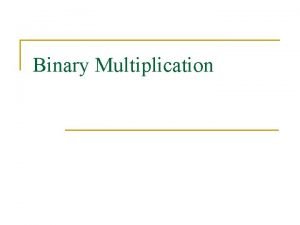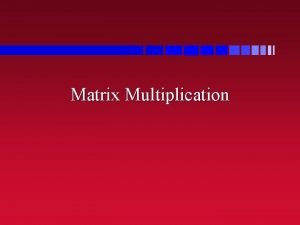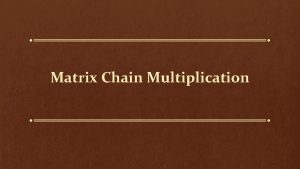CS 140 Matrix multiplication Matrix multiplication I parallel
















![3 -Loop Matrix Multiply [Alpern et al. , 1992] 12000 would take 1095 years 3 -Loop Matrix Multiply [Alpern et al. , 1992] 12000 would take 1095 years](https://slidetodoc.com/presentation_image/351cdcd8cdbf0889c44eceb53dc6ea63/image-17.jpg)
![3 -Loop Matrix Multiply [Alpern et al. , 1992] Page miss every iteration TLB 3 -Loop Matrix Multiply [Alpern et al. , 1992] Page miss every iteration TLB](https://slidetodoc.com/presentation_image/351cdcd8cdbf0889c44eceb53dc6ea63/image-18.jpg)





























- Slides: 47

CS 140 : Matrix multiplication • Matrix multiplication I : parallel issues • Matrix multiplication II: cache issues Thanks to Jim Demmel and Kathy Yelick (UCB) for some of these slides

Communication volume model • Network of p processors • Each with local memory • Message-passing • Communication volume (v) • Total size (words) of all messages passed during computation • Broadcasting one word costs volume p (actually, p-1) • No explicit accounting for communication time • Thus, can’t really model parallel efficiency or speedup; for that, we’d use the latency-bandwidth model (see extra slides)

Matrix-Matrix Multiplication {implements C = C + A*B} for i = 1 to n for j = 1 to n for k = 1 to n C(i, j) = C(i, j) + A(i, k) * B(k, j) Algorithm has 2*n 3 = O(n 3) Flops and operates on 3*n 2 words of memory C(i, j) A(i, : ) C(i, j) = + * B(: , j)

Parallel Matrix Multiply • Compute C = C + A*B • Basic sequential algorithm: • C(i, j) += A(i, 1)*B(1, j) + A(i, 2)*B(1, j) +…+ A(i, n)*B(n, j) • work = t 1 = 2 n 3 floating point operations (“flops”) • Variables are: • Data layout • Structure of communication • Schedule of communication

Parallel Matrix Multiply with 1 D Column Layout • Assume matrices are n x n and n is divisible by p p 0 p 1 p 2 p 3 p 4 p 5 p 6 p 7 (A reasonable assumption for analysis, not for code) • A(i) is the n-by-n/p block column that processor i owns (similarly B(i) and C(i)) • B(i, j) is a n/p-by-n/p sublock of B(i) • in rows j*n/p through (j+1)*n/p • Then: C(i) += A(0)*B(0, i) + A(1)*B(1, i) +…+ A(p-1)*B(p-1, i)

Matmul for 1 D layout on a Processor Ring • Proc k communicates only with procs k-1 and k+1 • Different pairs of processors can communicate simultaneously • Round-Robin “Merry-Go-Round” algorithm Copy A(myproc) into MGR (MGR = “Merry-Go-Round”) C(myproc) = C(myproc) + MGR*B(myproc , myproc) for j = 1 to p-1 send MGR to processor myproc+1 mod p (but see deadlock below) receive MGR from processor myproc-1 mod p (but see below) C(myproc) = C(myproc) + MGR * B( myproc-j mod p , myproc) • Avoiding deadlock: • even procs send then recv, odd procs recv then send • or, use nonblocking sends • Comm volume of one inner loop iteration = n 2

Matmul for 1 D layout on a Processor Ring • One iteration: v = n 2 • All p-1 iterations: v = (p-1) * n 2 ~ pn 2 • Optimal for 1 D data layout: • • Perfect speedup for arithmetic A(myproc) must meet each C(myproc) • “Nice” communication pattern – can probably overlap independent communications in the ring. • In latency/bandwidth model (see extra slides), parallel efficiency e = 1 - O(p/n)

Mat. Mul with 2 D Layout • Consider processors in 2 D grid (physical or logical) • Processors can communicate with 4 nearest neighbors • Alternative pattern: broadcast along rows and columns p(0, 0) p(0, 1) p(0, 2) p(1, 0) p(1, 1) p(1, 2) p(2, 0) p(2, 1) p(2, 2) = p(0, 0) p(0, 1) p(0, 2) p(1, 0) p(1, 1) p(1, 2) p(2, 0) p(2, 1) p(2, 2) • Assume p is square s x s grid * p(0, 0) p(0, 1) p(0, 2) p(1, 0) p(1, 1) p(1, 2) p(2, 0) p(2, 1) p(2, 2)

Cannon’s Algorithm: 2 -D merry-go-round … C(i, j) = C(i, j) + Sk A(i, k)*B(k, j) … assume s = sqrt(p) is an integer forall i=0 to s-1 … “skew” A left-circular-shift row i of A by i … so that A(i, j) overwritten by A(i, (j+i)mod s) forall i=0 to s-1 … “skew” B up-circular-shift B column i of B by i … so that B(i, j) overwritten by B((i+j)mod s), j) for k=0 to s-1 … sequential forall i=0 to s-1 and j=0 to s-1 … all processors in parallel C(i, j) = C(i, j) + A(i, j)*B(i, j) left-circular-shift each row of A by 1 up-circular-shift each row of B by 1

Cannon’s Matrix Multiplication C(1, 2) = A(1, 0) * B(0, 2) + A(1, 1) * B(1, 2) + A(1, 2) * B(2, 2)

Initial Step to Skew Matrices in Cannon • Initial blocked input A(0, 0) A(0, 1) A(0, 2) B(0, 0) B(0, 1) B(0, 2) A(1, 0) A(1, 1) A(1, 2) B(1, 0) B(1, 1) B(1, 2) A(2, 0) A(2, 1) A(2, 2) B(2, 0) B(2, 1) B(2, 2) • After skewing before initial block multiplies A(0, 0) A(0, 1) A(0, 2) B(0, 0) B(1, 1) B(2, 2) A(1, 1) A(1, 2) A(1, 0) B(2, 1) B(0, 2) A(2, 0) A(2, 1) B(2, 0) B(0, 1) B(1, 2)

Skewing Steps in Cannon • First step A(0, 0) A(0, 1) A(0, 2) B(0, 0) B(1, 1) B(2, 2) A(1, 1) A(1, 2) A(1, 0) B(2, 1) B(0, 2) A(2, 0) A(2, 1) B(2, 0) B(0, 1) B(1, 2) A(0, 1) A(0, 2) A(0, 0) B(1, 0) B(2, 1) B(0, 2) A(1, 0) A(1, 1) B(2, 0) B(0, 1) B(1, 2) A(2, 0) A(2, 1) A(2, 2) B(0, 0) B(1, 1) B(2, 2) A(0, 0) A(0, 1) B(2, 0) B(0, 1) B(1, 2) A(1, 0) A(1, 1) A(1, 2) B(0, 0) B(1, 1) B(2, 2) A(2, 1) A(2, 2) A(2, 0) B(1, 0) B(2, 1) B(0, 2) • Second • Third

Communication Volume of Cannon’s Algorithm forall i=0 to s-1 … recall s = sqrt(p) left-circular-shift row i of A by i … v = n 2 / s for each i forall i=0 to s-1 up-circular-shift B column i of B by i … v = n 2 / s for each i for k=0 to s-1 forall i=0 to s-1 and j=0 to s-1 C(i, j) = C(i, j) + A(i, j)*B(i, j) left-circular-shift each row of A by 1 … v = n 2 for each k up-circular-shift each row of B by 1 … v = n 2 for each k ° Total comm ° v = 2*n 2 + 2* s*n 2 ~ 2* sqrt(p)*n 2 Again, “nice” communication pattern ° In latency/bandwidth model (see extra slides), parallel efficiency e = 1 - O(sqrt(p)/n)

Drawbacks to Cannon • Hard to generalize for • • • p not a perfect square A and B not square dimensions of A, B not perfectly divisible by s = sqrt(p) A and B not “aligned” in the way they are stored on processors block-cyclic layouts • Memory hog (extra copies of local matrices) • Algorithm used instead in practice is SUMMA • uses row and column broadcasts, not merry-go-round • see extra slides below for details

Sequential Matrix Multiplication Simple mathematics, but getting good performance is complicated by memory hierarchy --- cache issues.

“Naïve” 3 -Loop Matrix Multiply {implements C = C + A*B} for i = 1 to n for j = 1 to n for k = 1 to n C(i, j) = C(i, j) + A(i, k) * B(k, j) Algorithm has 2*n 3 = O(n 3) Flops and operates on 3*n 2 words of memory C(i, j) A(i, : ) C(i, j) = + * B(: , j)
![3 Loop Matrix Multiply Alpern et al 1992 12000 would take 1095 years 3 -Loop Matrix Multiply [Alpern et al. , 1992] 12000 would take 1095 years](https://slidetodoc.com/presentation_image/351cdcd8cdbf0889c44eceb53dc6ea63/image-17.jpg)
3 -Loop Matrix Multiply [Alpern et al. , 1992] 12000 would take 1095 years T = N 4. 7 Size 2000 took 5 days O(N 3) performance would have constant cycles/flop Performance looks much closer to O(N 5) Slide source: Larry Carter, UCSD
![3 Loop Matrix Multiply Alpern et al 1992 Page miss every iteration TLB 3 -Loop Matrix Multiply [Alpern et al. , 1992] Page miss every iteration TLB](https://slidetodoc.com/presentation_image/351cdcd8cdbf0889c44eceb53dc6ea63/image-18.jpg)
3 -Loop Matrix Multiply [Alpern et al. , 1992] Page miss every iteration TLB miss every iteration Cache miss every 16 iterations Page miss every 512 iterations Slide source: Larry Carter, UCSD

Avoiding data movement: Reuse and locality Conventional Storage Proc Hierarchy Cache L 2 Cache Proc Cache L 2 Cache L 3 Cache Memory • Large memories are slow, fast memories are small • Parallel processors, collectively, have large, fast cache • the slow accesses to “remote” data we call “communication” • Algorithm should do most work on local data potential interconnects L 3 Cache

4 -core Intel Nehalem chip (2 per Triton node):

Triton memory hierarchy Node Chip Proc Proc Cache Cache L 2 Cache L 2 Cache L 3 Cache Node Memory <- Myrinet Interconnect to Other Nodes ->

Simplified model of hierarchical memory • Assume just 2 levels in the hierarchy, fast and slow • All data initially in slow memory • m = number of memory elements (words) moved between fast and slow memory • tm = time per slow memory operation • f = number of arithmetic operations • tf = time per arithmetic operation << tm • q = f / m average number of flops per slow element access • Minimum possible time = f* tf when all data in fast memory • Actual time • f * tf + m * tm = f * tf * (1 + tm/tf * 1/q) • Larger q means time closer to minimum f * tf

“Naïve” Matrix Multiply {implements C = C + A*B} for i = 1 to n {read row i of A into fast memory} for j = 1 to n {read C(i, j) into fast memory} {read column j of B into fast memory} for k = 1 to n C(i, j) = C(i, j) + A(i, k) * B(k, j) {write C(i, j) back to slow memory} C(i, j) A(i, : ) C(i, j) = + * B(: , j)

“Naïve” Matrix Multiply How many references to slow memory? m = n 3 read each column of B n times + n 2 read each row of A once + 2 n 2 read and write each element of C once = n 3 + 3 n 2 So q = f / m = 2 n 3 / (n 3 + 3 n 2) ~= 2 for large n, no improvement over matrix-vector multiply C(i, j) A(i, : ) C(i, j) = + * B(: , j)

Blocked Matrix Multiply Consider A, B, C to be N by N matrices of b by b subblocks where b=n / N is called the block size for i = 1 to N for j = 1 to N {read block C(i, j) into fast memory} for k = 1 to N {read block A(i, k) into fast memory} {read block B(k, j) into fast memory} C(i, j) = C(i, j) + A(i, k) * B(k, j) {do a matrix multiply on blocks} {write block C(i, j) back to slow memory} C(i, j) A(i, k) C(i, j) = + * B(k, j)

Blocked Matrix Multiply m is amount memory traffic between slow and fast memory matrix has nxn elements, and Nx. N blocks each of size bxb f is number of floating point operations, 2 n 3 for this problem q = f / m measures data reuse, or computational intensity m = N*n 2 read every block of B N times + N*n 2 read every block of A N times + 2 n 2 read and write every block of C once = (2 N + 2) * n 2 Computational intensity q = f / m = 2 n 3 / ((2 N + 2) * n 2) ~= n / N = b for large n We can improve performance by increasing the blocksize b (but only until 3 b 2 gets as big as the fast memory size) Can be much faster than matrix-vector multiply (q=2)

Multi-Level Blocked Matrix Multiply • More levels of memory hierarchy => more levels of blocking! • Version 1: One level of blocking for each level of memory (L 1 cache, L 2 cache, L 3 cache, DRAM, disk, …) • Version 2: Recursive blocking, O(log n) levels deep In the “Uniform Memory Hierarchy” cost model, the 3 -loop algorithm is O(N 5) time, but the blocked algorithms are O(N 3)

BLAS: Basic Linear Algebra Subroutines • Industry standard interface • Vendors, others supply optimized implementations • History • BLAS 1 (1970 s): • vector operations: dot product, saxpy (y=a*x+y), etc • m=2*n, f=2*n, q ~1 or less • BLAS 2 (mid 1980 s) • matrix-vector operations: matrix vector multiply, etc • m=n^2, f=2*n^2, q~2, less overhead • somewhat faster than BLAS 1 • BLAS 3 (late 1980 s) • matrix-matrix operations: matrix multiply, etc • m >= n^2, f=O(n^3), so q can possibly be as large as n • BLAS 3 is potentially much faster than BLAS 2 • Good algorithms use BLAS 3 when possible (LAPACK) • See www. netlib. org/blas, www. netlib. org/lapack

BLAS speeds on an IBM RS 6000/590 Peak speed = 266 Mflops Peak BLAS 3 BLAS 2 BLAS 1 BLAS 3 (n-by-n matrix multiply) vs BLAS 2 (n-by-n matrix vector multiply) vs BLAS 1 (saxpy of n vectors)

Sca. LAPACK Parallel Library

Extra Slides: Parallel matrix multiplication in the latency-bandwidth cost model

Latency Bandwidth Model • Network of p processors, each with local memory • Message-passing • Latency (a) • Cost of communication per message • Inverse bandwidth (b) • Cost of communication per unit of data • Parallel time (tp) • Computation time plus communication time • Parallel efficiency: • e(p) = t 1 / (p * tp) • perfect speedup e(p) = 1

Matrix Multiply with 1 D Column Layout • Assume matrices are n x n and n is divisible by p p 0 p 1 p 2 p 3 p 4 p 5 p 6 p 7 May be a reasonable assumption for analysis, not for code • A(i) is the n-by-n/p block column that processor i owns (similarly B(i) and C(i)) • B(i, j) is the n/p-by-n/p sublock of B(i) • in rows j*n/p through (j+1)*n/p • Formula: C(i) = C(i) + A*B(i) = C(i) + Sj=0: p A(j) * B(j, i)

Matmul for 1 D layout on a Processor Ring • Proc k communicates only with procs k-1 and k+1 • Different pairs of processors can communicate simultaneously • Round-Robin “Merry-Go-Round” algorithm Copy A(myproc) into MGR (MGR = “Merry-Go-Round”) C(myproc) = C(myproc) + MGR*B(myproc , myproc) for j = 1 to p-1 send MGR to processor myproc+1 mod p (but see deadlock below) receive MGR from processor myproc-1 mod p (but see below) C(myproc) = C(myproc) + MGR * B( myproc-j mod p , myproc) • Avoiding deadlock: • even procs send then recv, odd procs recv then send • or, use nonblocking sends • Time of inner loop = 2*(a + b*n 2/p) + 2*n*(n/p)2

Matmul for 1 D layout on a Processor Ring • Time of inner loop = 2*(a + b*n 2/p) + 2*n*(n/p)2 • Total Time = 2*n* (n/p)2 + (p-1) * Time of inner loop • ~ 2*n 3/p + 2*p* a + 2* b*n 2 • Optimal for 1 D layout on Ring or Bus, even with broadcast: • • Perfect speedup for arithmetic A(myproc) must move to each other processor, costs at least (p-1)*cost of sending n*(n/p) words • Parallel Efficiency = 2*n 3 / (p * Total Time) = 1/(1 + a * p 2/(2*n 3) + b * p/(2*n) ) = 1/ (1 + O(p/n)) = 1 - O(p/n) • Grows to 1 as n/p increases (or a and b shrink)

Mat. Mul with 2 D Layout • Consider processors in 2 D grid (physical or logical) • Processors can communicate with 4 nearest neighbors • Alternative pattern: broadcast along rows and columns p(0, 0) p(0, 1) p(0, 2) p(1, 0) p(1, 1) p(1, 2) p(2, 0) p(2, 1) p(2, 2) = p(0, 0) p(0, 1) p(0, 2) p(1, 0) p(1, 1) p(1, 2) p(2, 0) p(2, 1) p(2, 2) • Assume p is square s x s grid * p(0, 0) p(0, 1) p(0, 2) p(1, 0) p(1, 1) p(1, 2) p(2, 0) p(2, 1) p(2, 2)

Cannon’s Algorithm: 2 -D merry-go-round … C(i, j) = C(i, j) + Sk A(i, k)*B(k, j) … assume s = sqrt(p) is an integer forall i=0 to s-1 … “skew” A left-circular-shift row i of A by i … so that A(i, j) overwritten by A(i, (j+i)mod s) forall i=0 to s-1 … “skew” B up-circular-shift B column i of B by i … so that B(i, j) overwritten by B((i+j)mod s), j) for k=0 to s-1 … sequential forall i=0 to s-1 and j=0 to s-1 … all processors in parallel C(i, j) = C(i, j) + A(i, j)*B(i, j) left-circular-shift each row of A by 1 up-circular-shift each row of B by 1

Cannon’s Matrix Multiplication C(1, 2) = A(1, 0) * B(0, 2) + A(1, 1) * B(1, 2) + A(1, 2) * B(2, 2)

Initial Step to Skew Matrices in Cannon • Initial blocked input A(0, 0) A(0, 1) A(0, 2) B(0, 0) B(0, 1) B(0, 2) A(1, 0) A(1, 1) A(1, 2) B(1, 0) B(1, 1) B(1, 2) A(2, 0) A(2, 1) A(2, 2) B(2, 0) B(2, 1) B(2, 2) • After skewing before initial block multiplies A(0, 0) A(0, 1) A(0, 2) B(0, 0) B(1, 1) B(2, 2) A(1, 1) A(1, 2) A(1, 0) B(2, 1) B(0, 2) A(2, 0) A(2, 1) B(2, 0) B(0, 1) B(1, 2)

Skewing Steps in Cannon • First step A(0, 0) A(0, 1) A(0, 2) B(0, 0) B(1, 1) B(2, 2) A(1, 1) A(1, 2) A(1, 0) B(2, 1) B(0, 2) A(2, 0) A(2, 1) B(2, 0) B(0, 1) B(1, 2) A(0, 1) A(0, 2) A(0, 0) B(1, 0) B(2, 1) B(0, 2) A(1, 0) A(1, 1) B(2, 0) B(0, 1) B(1, 2) A(2, 0) A(2, 1) A(2, 2) B(0, 0) B(1, 1) B(2, 2) A(0, 0) A(0, 1) B(2, 0) B(0, 1) B(1, 2) A(1, 0) A(1, 1) A(1, 2) B(0, 0) B(1, 1) B(2, 2) A(2, 1) A(2, 2) A(2, 0) B(1, 0) B(2, 1) B(0, 2) • Second • Third

Cost of Cannon’s Algorithm forall i=0 to s-1 … recall s = sqrt(p) left-circular-shift row i of A by i … cost = s*(a + b*n 2/p) forall i=0 to s-1 up-circular-shift B column i of B by i … cost = s*(a + b*n 2/p) for k=0 to s-1 forall i=0 to s-1 and j=0 to s-1 C(i, j) = C(i, j) + A(i, j)*B(i, j) … cost = 2*(n/s)3 = 2*n 3/p 3/2 left-circular-shift each row of A by 1 … cost = a + b*n 2/p up-circular-shift each row of B by 1 … cost = a + b*n 2/p ° Total Time = 2*n 3/p + 4* s*alpha + 4*beta*n 2/s ° Parallel Efficiency = 2*n 3 / (p * Total Time) = 1/( 1 + a * 2*(s/n)3 + b * 2*(s/n) ) = 1 - O(sqrt(p)/n) ° Grows to 1 as n/s = n/sqrt(p) = sqrt(data per processor) grows ° Better than 1 D layout, which had Efficiency = 1 - O(p/n)

Extra Slides: SUMMA parallel matrix multiplication algorithm

SUMMA Algorithm • SUMMA = Scalable Universal Matrix Multiply • Slightly less efficient than Cannon … but simpler and easier to generalize • Presentation from van de Geijn and Watts • www. netlib. org/lapack/lawns/lawn 96. ps • Similar ideas appeared many times • Used in practice in PBLAS = Parallel BLAS • www. netlib. org/lapack/lawns/lawn 100. ps

SUMMA k J B(k, J) k I * = C(I, J) A(I, k) I, J represent all rows, columns owned by a processor • k is a single row or column • or a block of b rows or columns • • C(I, J) = C(I, J) + Sk A(I, k)*B(k, J) • Assume a pr by pc processor grid (pr = pc = 4 above) • Need not be square

SUMMA k J B(k, J) k * I = C(I, J) A(I, k) For k=0 to n-1 … or n/b-1 where b is the block size … = # cols in A(I, k) and # rows in B(k, J) for all I = 1 to pr … in parallel owner of A(I, k) broadcasts it to whole processor row for all J = 1 to pc … in parallel owner of B(k, J) broadcasts it to whole processor column Receive A(I, k) into Acol Receive B(k, J) into Brow C( myproc , myproc ) = C( myproc , myproc) + Acol * Brow

SUMMA performance ° To simplify analysis only, assume s = sqrt(p) For k=0 to n/b-1 for all I = 1 to s … s = sqrt(p) owner of A(I, k) broadcasts it to whole processor row … time = log s *( a + b * b*n/s), using a tree for all J = 1 to s owner of B(k, J) broadcasts it to whole processor column … time = log s *( a + b * b*n/s), using a tree Receive A(I, k) into Acol Receive B(k, J) into Brow C( myproc , myproc ) = C( myproc , myproc) + Acol * Brow … time = 2*(n/s)2*b ° Total time = 2*n 3/p + a * log p * n/b + b * log p * n 2 /s

SUMMA performance • Total time = 2*n 3/p + a * log p * n/b + b * log p * n 2 /s • Parallel Efficiency = 1/(1 + a * log p * p / (2*b*n 2) + b * log p * s/(2*n) ) • ~Same b term as Cannon, except for log p factor log p grows slowly so this is ok • Latency (a) term can be larger, depending on b When b=1, get a * log p * n As b grows to n/s, term shrinks to a * log p * s (log p times Cannon) • Temporary storage grows like 2*b*n/s • Can change b to tradeoff latency cost with memory
 A pair of unlike parallel forces
A pair of unlike parallel forces It refers to inner terminus
It refers to inner terminus Parallelism
Parallelism Parallel structure purdue owl
Parallel structure purdue owl Parallel structure def
Parallel structure def 4 bit shift register
4 bit shift register Parallelism in literature
Parallelism in literature Fox algorithm matrix multiplication
Fox algorithm matrix multiplication Matrix multiplication time complexity
Matrix multiplication time complexity Matrix chain multiplication definition
Matrix chain multiplication definition Chain matrix multiplication dynamic programming
Chain matrix multiplication dynamic programming Matrix vector multiplication by mapreduce
Matrix vector multiplication by mapreduce Hadoop matrix multiplication
Hadoop matrix multiplication Cuda matrix multiplication
Cuda matrix multiplication Gpu
Gpu Matrix
Matrix Matrix algebra for linear models
Matrix algebra for linear models Elvina chu
Elvina chu Multiplication of determinants
Multiplication of determinants Multiplication of 3x3 matrix
Multiplication of 3x3 matrix Matrix multiplication runtime
Matrix multiplication runtime Matrix chain multiplication 알고리즘
Matrix chain multiplication 알고리즘 Invert the matrix
Invert the matrix Scalar multiplication matrix
Scalar multiplication matrix Elementary matrix
Elementary matrix Fuzzy matrix definition
Fuzzy matrix definition Anatomy of high-performance matrix multiplication
Anatomy of high-performance matrix multiplication Matrix multiplication associative property
Matrix multiplication associative property Transpose rules
Transpose rules Diagonal matrix properties
Diagonal matrix properties Matrix vector multiplication by mapreduce
Matrix vector multiplication by mapreduce Cuda matrix multiplication optimization
Cuda matrix multiplication optimization Matrix multiplication table
Matrix multiplication table Indr 262
Indr 262 Matrix
Matrix Partitioned matrix
Partitioned matrix Cache matrix multiplication
Cache matrix multiplication Vivado hls matrix multiplication example
Vivado hls matrix multiplication example Matrix multiplication
Matrix multiplication Matrix multiplication table
Matrix multiplication table Mat lab
Mat lab Raphael yuster
Raphael yuster Cuda bank conflict
Cuda bank conflict Matlab sparse matrix multiplication
Matlab sparse matrix multiplication Matrix multiplication mips
Matrix multiplication mips Theano matrix multiplication
Theano matrix multiplication Mul instruction in assembly language
Mul instruction in assembly language Min-plus matrix multiplication
Min-plus matrix multiplication







